The transduction efficiency increase observed when using the ExpressMag products will depend on the cell line. It is reasonable to expect a roughly 10-fold or greater increase.
SHM01
ExpressMag® Super Magnetic Kit
Increases transduction efficiency
About This Item
Productos recomendados
Línea del producto
MISSION®
caducidad
≥2 yr at ~4 °C
temp. de almacenamiento
2-8°C
Descripción general
www.sigmaaldrich.com/mission-protocols
Aplicación
Precaución
Información legal
Código de clase de almacenamiento
10 - Combustible liquids
Punto de inflamabilidad (°F)
Not applicable
Punto de inflamabilidad (°C)
Not applicable
Elija entre una de las versiones más recientes:
Certificados de análisis (COA)
It looks like we've run into a problem, but you can still download Certificates of Analysis from our Documentos section.
Si necesita más asistencia, póngase en contacto con Atención al cliente
¿Ya tiene este producto?
Encuentre la documentación para los productos que ha comprado recientemente en la Biblioteca de documentos.
Artículos
Lentiviral vector systems prioritize safety features, with design precautions preventing replication. Good handling practices are essential for use.
Get tips for handling lentiviruses, optimizing experiment setup, titering lentivirus particles, and selecting helpful products for transduction.
Protocolos
This detailed procedure allows you to transduce Mouse Embryonic Fibroblasts (MEF) using MISSION ExpressMag Super Magnetic Kit.
Lentivirus versions of genome modification technologies support successful CRISPR, RNAi, and ORF experiments.
FACS sorts cells based on light scattering and fluorescence for objective cell analysis.
-
What is the typical fold increase in transduction efficiency when using ExpressMag beads?
1 answer-
Helpful?
-
-
What other viruses have been successfully introduced into cells via the use of ExpressMag beads?
1 answer-
Adenovirus, SIV, Retrovirus, Measles virus and HIV have all been successfully introduced into cells using ExpressMag.
Helpful?
-
-
What is the Department of Transportation shipping information for this product?
1 answer-
Transportation information can be found in Section 14 of the product's (M)SDS.To access the shipping information for this material, use the link on the product detail page for the product.
Helpful?
-
-
What cell lines have been transduced successfully using ExpressMag Beads?
1 answer-
The following cell types have been successfully transduced using ExpressMag Beads: PBL, PBMC, T Cells, GMB primary tumor cells, A549, NYGM, T98G, U251, U87,YH-13, YK6-1, KS-1, NIH3T3, K562, Vero, HeLa, CHO, L929, B95a, H9, HUVEC, CD4+ Primary Human T-Cells, Human Bone Marrow Macrophages, Primary Keratinocytes, SKOV3, MM-AN, MEF and CD 34+.
Helpful?
-
-
How does the storage temperature relate to shipping conditions?
1 answer-
The storage conditions that a Sigma-Aldrich catalog and label recommend for products are deliberately conservative. For many products, long-term storage at low temperatures will increase the time during which they are expected to remain in specification and therefore are labeled accordingly. Where short-term storage, shipping time frame, or exposure to conditions other than those recommended for long-term storage will not affect product quality, Sigma-Aldrich will ship at ambient temperature. The products sensitive to short-term exposure to conditions other than their recommended long-term storage are shipped on wet or dry ice. Ambient temperature shipping helps to control shipping costs for our customers. At any time, our customers can request wet- or dry-ice shipment, but the special handling is at customer expense if our product history indicates that the product is stable for regular shipment.
Helpful?
-
-
What MISSION products have been successfully introduced into cells using ExpressMag® beads?
1 answer-
MISSION Lentiviral Particles (various targets/clones), SHC002V, SHC003V and SHC008V have been successfully introduced into cells using ExpressMag beads.
Helpful?
-
Active Filters
Nuestro equipo de científicos tiene experiencia en todas las áreas de investigación: Ciencias de la vida, Ciencia de los materiales, Síntesis química, Cromatografía, Analítica y muchas otras.
Póngase en contacto con el Servicio técnico








